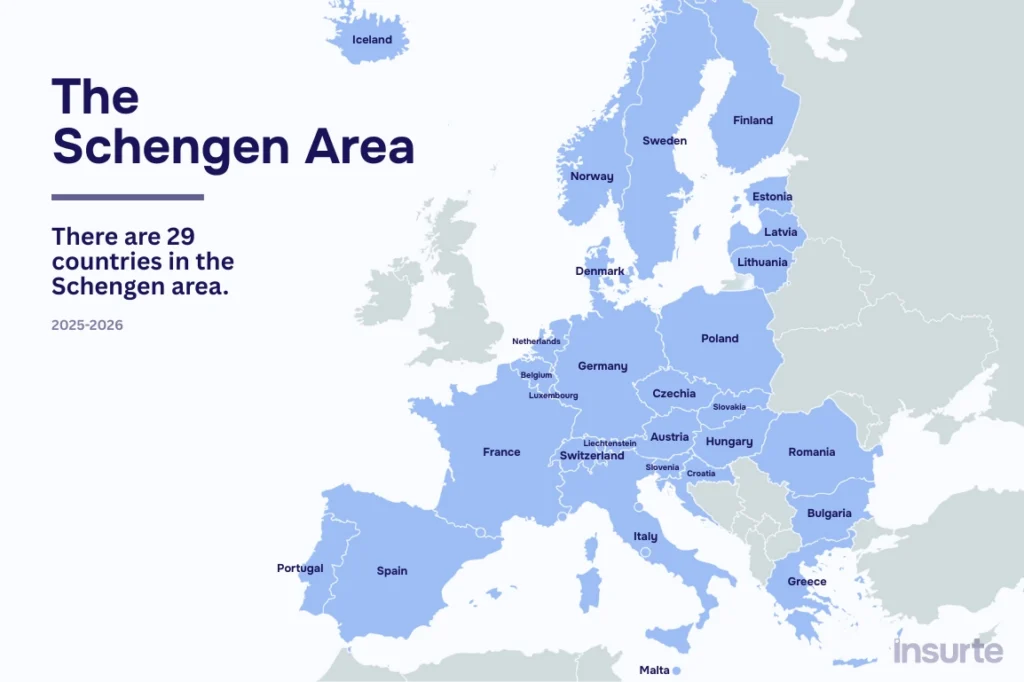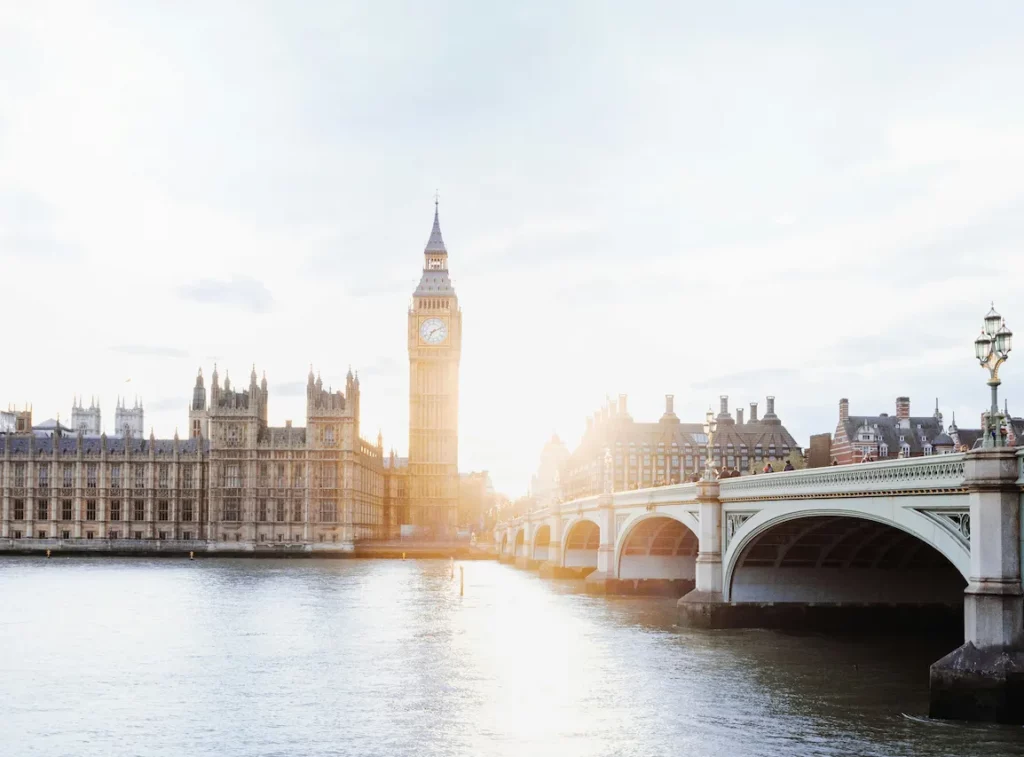Home > Everything You Need to Know About the Schengen Zone
Everything You Need to Know About the Schengen Zone
You may have heard about the Schengen zone, especially if you have traveled to Europe before (or are planning a trip to travel there soon!). But... what is it exactly?
The Schengen zone (also called the Schengen area) is a unique agreement that benefits both the countries in the zone and travelers that go to and from.
It also simplifies migration processes like tourist trips and visa applications.
We're going to break down everything you need to know about the Schengen zone, including its member countries, travel requirements (such as Schengen visa travel insurance), and more, giving you a solid understanding of what it is.

What is the Schengen area?
What is the Schengen area? It is a group of 29 European countries.
These countries have decided to get rid of border checks between them. This means that travelers can go from member country to member country without having to go through passport control each time they exit and enter a new one.
You can think of it sort of like traveling from state to state in the USA. There's no need to go through a border check; you simply pass through.
On top of that, the countries in this zone have all decided to use a shared migration process. This means that the visa requirements and processes for short trips are the same, whether you're heading to France, Italy, Romania, or somewhere else in the zone.
How the Schengen area works
In order to enter the Schengen area, there are strict requirements for travelers.
Because of these strong requirements and thorough border checks at the first point of entry, the entire area remains secure.
More than 425 million people, including EU citizens, non-EU nationals living in the EU, and visitors, benefit from this agreement for free movement.
When did the Schengen area begin?
The Schengen zone exists today thanks to the Schengen Agreement.
This agreement was signed in Schengen, Luxembourg (sounds familiar, huh?) in 1985. In the beginning, there were far fewer countries in the area than there are today.
Today, there are 29 countries, with the possibility of even more in the future. For instance, Cyprus is on its way towards membership.
One thing that a lot of people mix up is the Schengen area versus the European Union.
While there is a lot of overlap, they are two entirely different things.

Which countries are in the Schengen zone?
The Schengen area has 29 members (so, 29 countries). Most of them are also in the European Union, but a few non-EU countries are also part of the zone (such as Norway and Iceland).
The current members of the Schengen area are:
Austria, Belgium, Bulgaria, Croatia, the Czech Republic, Denmark Estonia, Finland, France, Germany, Greece, Hungary, Iceland, Italy, Latvia, Liechtenstein, Lithuania, Luxembourg, Malta, the Netherlands, Norway, Poland, Portugal, Romania, Slovakia, Slovenia, Spain, Sweden, and Switzerland.
While most EU countries are members of the Schengen area too, not all of them are. For example, Ireland is in the EU, but it isn't in the Schengen area. The same is true for Cyprus, for now.
The process to join the Schengen area is a lengthy one with detailed criteria to meet.
Which countries in Europe are not in the Schengen area?
Most countries in Western Europe are part of the Schengen area, but not all of them. Fewer countries in Eastern Europe are in the zone.
The following countries are not in the Schengen area:
Albania, Armenia, Azerbaijan, Belarus, Bosnia & Herzegovina, Cyprus, the Faroe Islands (an autonomous territory of Denmark. Denmark is in the Schengen area), Greenland (also owned by Denmark), Ireland, Kosovo, Macedonia, Moldova, Montenegro, Serbia, the Russian Federation, Ukraine, and the United Kingdom (which includes England, Scotland, Wales, and Northern Ireland).
Schengen area “exceptions”
There are a few countries that are "de facto" members of the Schengen area because of their geographical locations and/or relationships with surrounding governments.
Included in the Schengen area are:
Andorra, Monaco, San Marino, and Vatican City.
This means that the vast majority of travelers who meet the requirements to enter the zone can visit these places too.

The UK is not in the Schengen area
The United Kingdom isn’t part of the Schengen zone, and it wasn’t before Brexit either.
The UK has opted out of the Schengen agreement because it prefers to maintain its own border controls. To be a part of the Schengen area, countries have to agree on external border policies and to collaborate closely.
The UK was in the European Union before, but since Brexit, they're even more distinct from the Schengen area.
Visitors traveling between the UK and Schengen countries must go through border checks, as there isn’t free movement.
If a non-exempt traveler wants to visit Paris and London in the same trip, they may have to apply for two different visas. Whereas if they want to travel to Paris and Barcelona, they would only need one visa (as both Paris and Barcelona are in the Schengen area, but London is not).
How the Schengen border works
When countries become a part of the Schengen area, there's a lot more to it than the absence of border checks for travelers passing through.
As noted above, there's a common set of rules that member countries have to agree to in order to be a member, and it's all about border management.
You might be thinking to yourself: the Schengen area. Is it a geographical area/region?
It isn't. The Schengen area includes many different countries all over Europe. Some have neighboring borders; one (Iceland) doesn't even share any physical borders with another Schengen country.
Being in the Schengen area isn't about the geographical location of a country (though to be fair, they are all in Europe). Whether or not a country gets to be in the Schengen area doesn't rely on where exactly it's geographically located. Again, other than the fact it is a European country.
Travelers who enter the Schengen area from non-Schengen countries (such as the US or Canada, for instance) have to go through stringent external border checks. These border checks are agreed upon by all Schengen members.
It's not just border processes either. Schengen countries also cooperate when it comes to judicial matters and police. Legal authorities often work together to prevent crime, particularly cross-border crime.
One big resource they lean on is a shared system called the Schengen Information System (SIS). SIS is a database that manages information about individuals, vehicles, and objects across all of the Schengen countries. They also rely on the Visa Information System (VIS), which is similar in that it is a database, but it serves a different purpose.
This allows police in one country to look at a more detailed history of a person, vehicle, or item that has come into the zone and moved around, which helps solve crimes faster (among other things).
But for travelers, the most noticeable perk is the "border-control-free movement" from country to country.
Still, that isn't to say there will never be border controls within the Schengen area.
In fact, border controls can be temporarily reintroduced from time to time in specific countries - if there's a serious threat to public order or national security, for example.
Efforts are always being made to reform and strengthen the area.
All in all, you can rest assured that even though there is free movement from one member country to another, the Schengen area as its whole is secure, thanks in large part to those Schengen border policies.
The newest members
In 2024, Bulgaria and Romania became the newest members of the Schengen area.
After a quite thorough evaluation process, both countries met the criteria for joining. This includes agreeing to adhere to the Schengen rules on border control, Schengen issuance, local police cooperation, and implementing SIS technologies.
As mentioned above, Cyprus is working towards membership. Even if they meet all of the technical requirements, they will still need to be voted in unanimously.